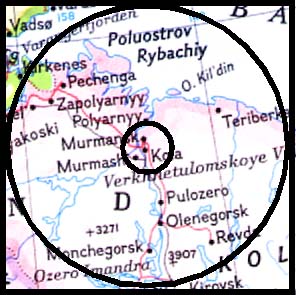




City, Country
Polyarnye Zori,
Kola peninsula, Russia
Number & type of Reactors
2x VVER-440/230
2x VVER-440/213
Net Electric Power as % in 92 of national total
1644 MWe
1% of national prod.
Major population Centers in a 150 km radius and
total estimated population of 150 km r. region
Approximately 200,000, including Kandalksha, Apatity, Kirovsk, Monchogorsk. Plus the edge of North Finnland
Date of commercial operation start up
or (if unfinished) date of construction start.
Operating; Start Up 1973, 1974, 1981, 1984. Fifth and sixth (VVER-1000) under construction
Operator/Builder
Rosenergoatom - operator; Atomenergostroy - builder;
VVER-1000 / safety contractor: Imatran Voima, Finland
There is great potential for a serious accident at Kola due to human error, unfunded safety problems or worker sabotage. In 1994, workers staged a sit-in, protesting delays in pay. There have been phone threats to set Kola a fire if wages were not paid. A significant number of workers have left because wages no longer compensated for the harsh working conditions inside the Arctic Circle. Many Kola customers fail to pay their bills including the giant nickel smelter at Nikel. Consequently, management attention is being diverted away from the serious safety problems toward fund-raising. As a result of the failure to pass legislation granting nuclear regulating organizations (e.g.,GAN) legal authority, no substantive enforcement actions can be taken against operating nuclear plants in Russia. Studies have revealed about 100 deviations from the safety rules at the Kola NPP. Plus reconstruction of the plant's roof involving replacement of the inflammable insulation materials has not been done. Nor have the cable conduits been treated with fire-resistant substances. Kola-1 suffered a blackout in 93 after a storm knocked out off-site power and emergency diesel generators repeatedly failed to start.


